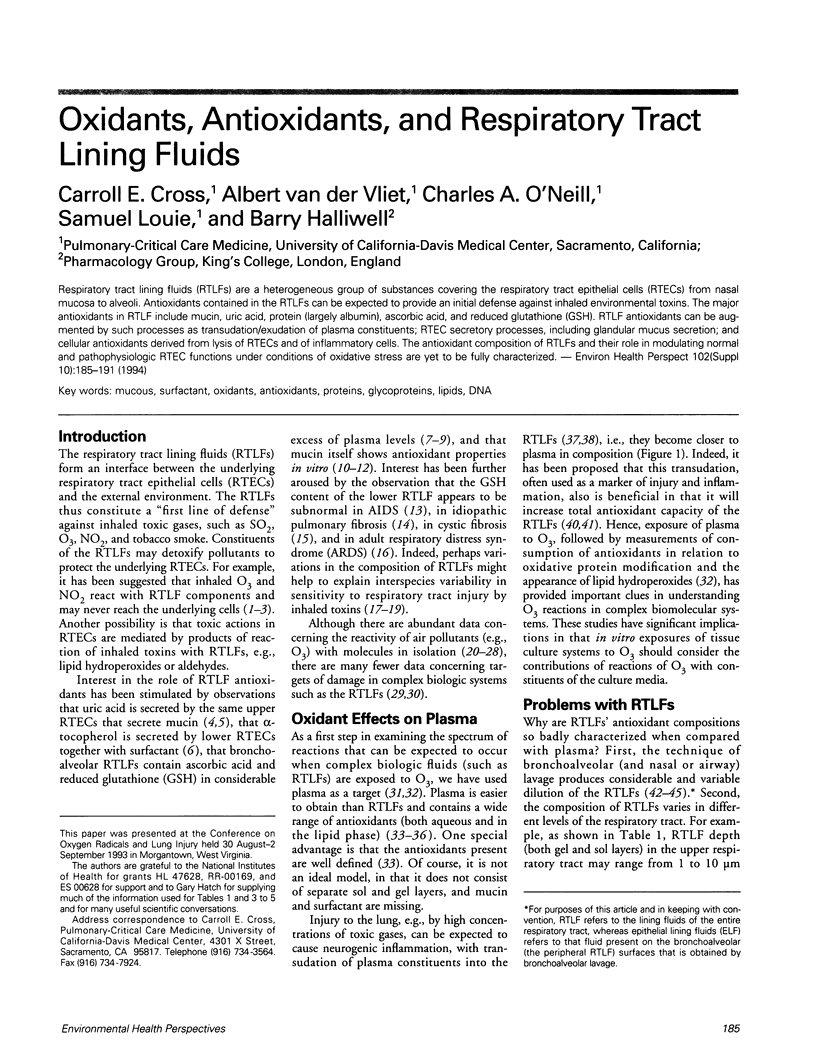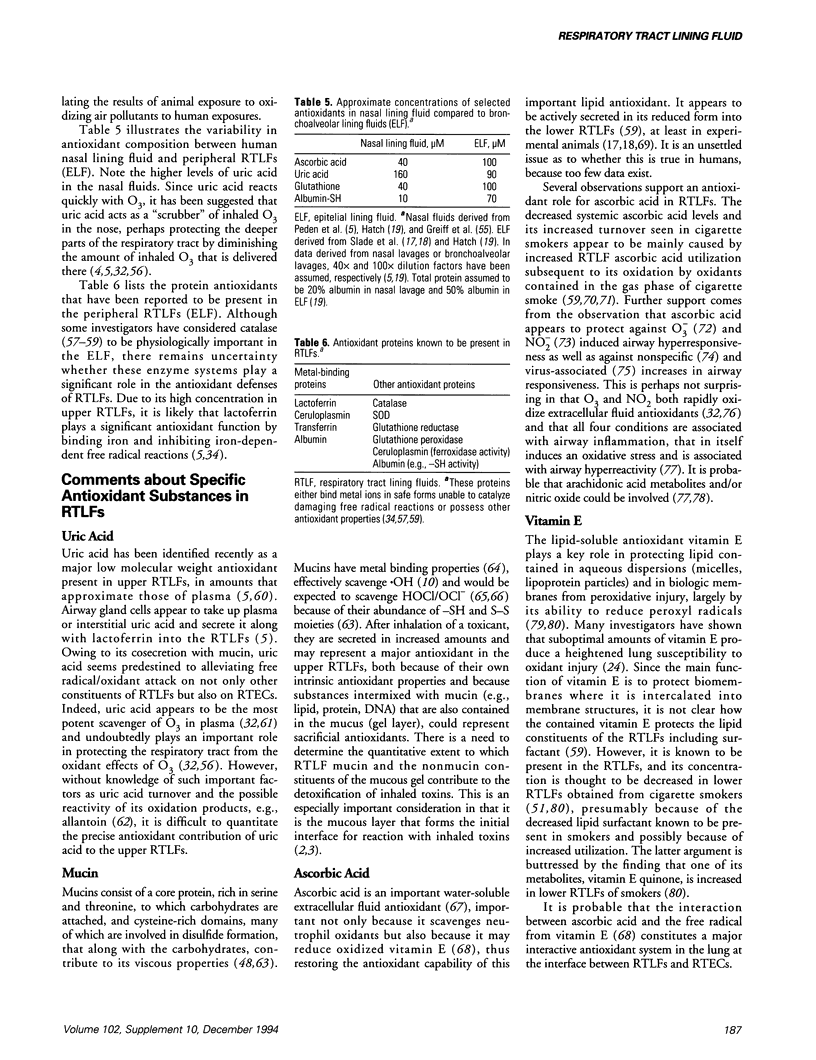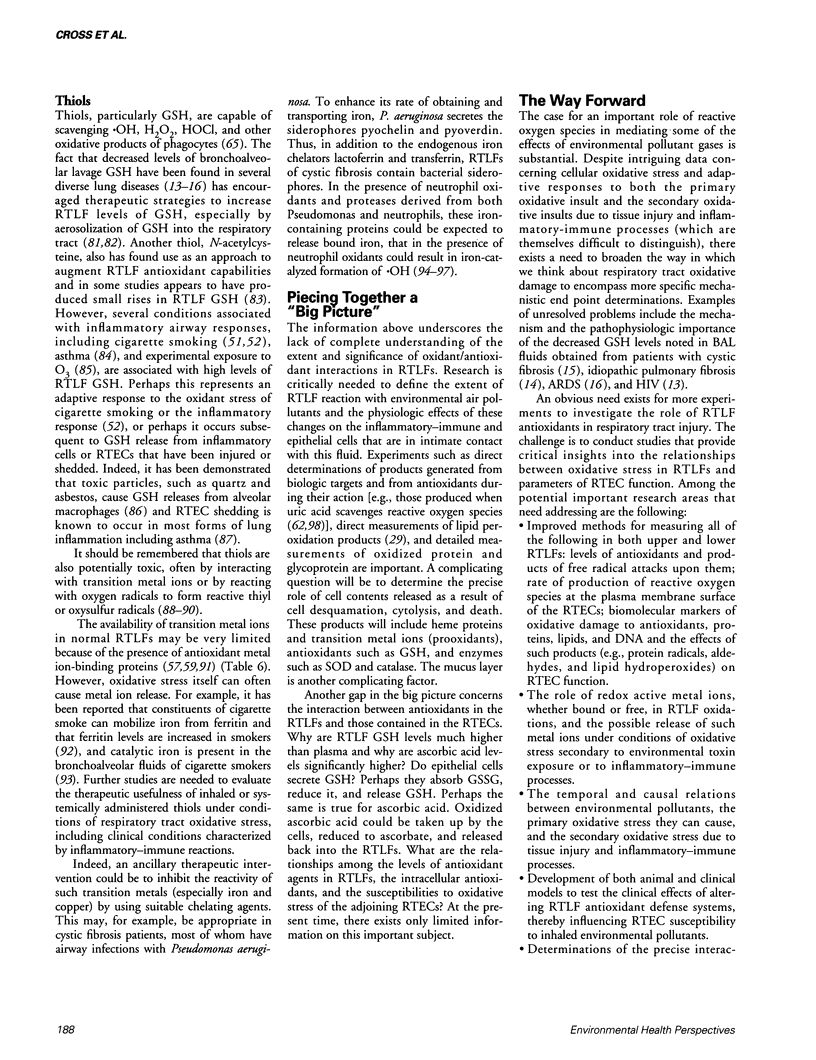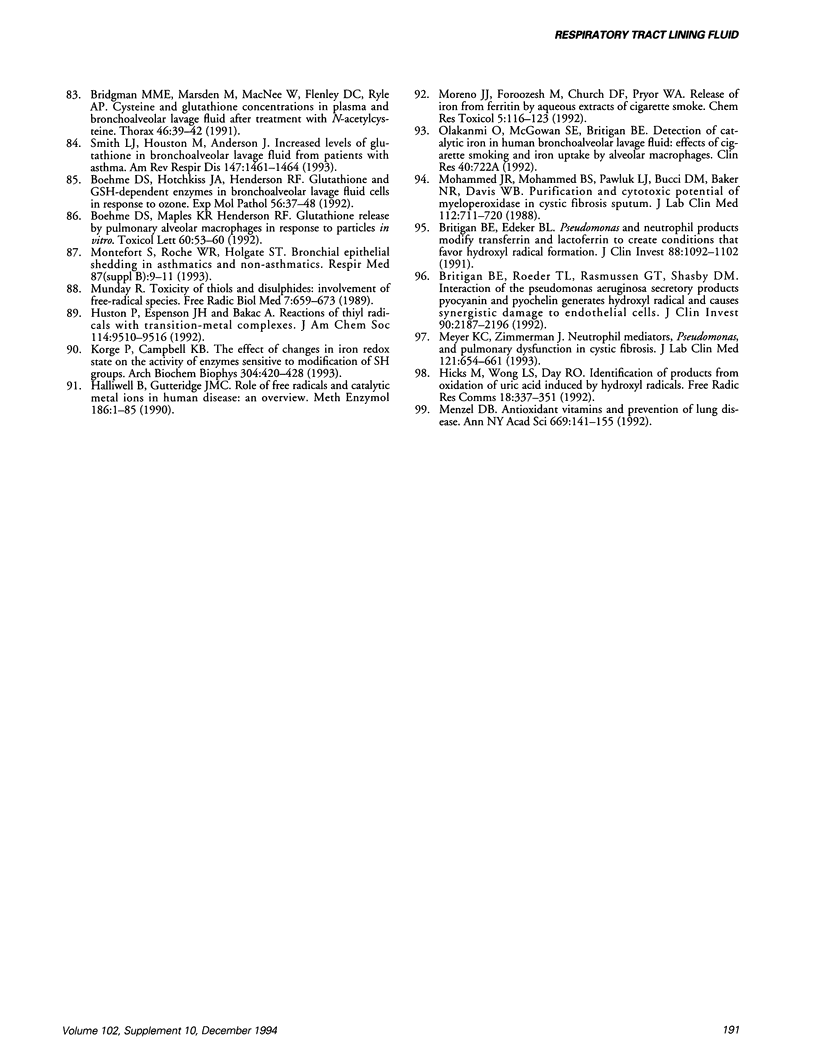Abstract
Respiratory tract lining fluids (RTLFs) are a heterogeneous group of substances covering the respiratory tract epithelial cells (RTECs) from nasal mucosa to alveoli. Antioxidant contained in the RTLFs can be expected to provide an initial defense against inhaled environmental toxins. The major antioxidants in RTLF include mucin, uric acid, protein (largely albumin), ascorbic acid, and reduced glutathione (GSH). RTLF antioxidants can be augmented by such processes as transudation/exudation of plasma constituents; RTEC secretory processes, including glandular mucus secretion; and cellular antioxidants derived from lysis of RTECs and of inflammatory cells. The antioxidant composition of RTLFs and their role in modulating normal and pathophysiologic RTEC functions under conditions of oxidative stress are yet to be fully characterized.
Full text
PDF






Selected References
These references are in PubMed. This may not be the complete list of references from this article.
- Ames B. N., Cathcart R., Schwiers E., Hochstein P. Uric acid provides an antioxidant defense in humans against oxidant- and radical-caused aging and cancer: a hypothesis. Proc Natl Acad Sci U S A. 1981 Nov;78(11):6858–6862. doi: 10.1073/pnas.78.11.6858. [DOI] [PMC free article] [PubMed] [Google Scholar]
- Aruoma O. I., Halliwell B., Hoey B. M., Butler J. The antioxidant action of N-acetylcysteine: its reaction with hydrogen peroxide, hydroxyl radical, superoxide, and hypochlorous acid. Free Radic Biol Med. 1989;6(6):593–597. doi: 10.1016/0891-5849(89)90066-x. [DOI] [PubMed] [Google Scholar]
- Barnes P. J. Nitric oxide and airways. Eur Respir J. 1993 Feb;6(2):163–165. [PubMed] [Google Scholar]
- Barnes P. J. Reactive oxygen species and airway inflammation. Free Radic Biol Med. 1990;9(3):235–243. doi: 10.1016/0891-5849(90)90034-g. [DOI] [PubMed] [Google Scholar]
- Boehme D. S., Hotchkiss J. A., Henderson R. F. Glutathione and GSH-dependent enzymes in bronchoalveolar lavage fluid cells in response to ozone. Exp Mol Pathol. 1992 Feb;56(1):37–48. doi: 10.1016/0014-4800(92)90021-3. [DOI] [PubMed] [Google Scholar]
- Boehme D. S., Maples K. R., Henderson R. F. Glutathione release by pulmonary alveolar macrophages in response to particles in vitro. Toxicol Lett. 1992 Jan;60(1):53–60. doi: 10.1016/0378-4274(92)90046-m. [DOI] [PubMed] [Google Scholar]
- Borok Z., Buhl R., Grimes G. J., Bokser A. D., Hubbard R. C., Holroyd K. J., Roum J. H., Czerski D. B., Cantin A. M., Crystal R. G. Effect of glutathione aerosol on oxidant-antioxidant imbalance in idiopathic pulmonary fibrosis. Lancet. 1991 Jul 27;338(8761):215–216. doi: 10.1016/0140-6736(91)90350-x. [DOI] [PubMed] [Google Scholar]
- Bridgeman M. M., Marsden M., MacNee W., Flenley D. C., Ryle A. P. Cysteine and glutathione concentrations in plasma and bronchoalveolar lavage fluid after treatment with N-acetylcysteine. Thorax. 1991 Jan;46(1):39–42. doi: 10.1136/thx.46.1.39. [DOI] [PMC free article] [PubMed] [Google Scholar]
- Britigan B. E., Edeker B. L. Pseudomonas and neutrophil products modify transferrin and lactoferrin to create conditions that favor hydroxyl radical formation. J Clin Invest. 1991 Oct;88(4):1092–1102. doi: 10.1172/JCI115408. [DOI] [PMC free article] [PubMed] [Google Scholar]
- Britigan B. E., Roeder T. L., Rasmussen G. T., Shasby D. M., McCormick M. L., Cox C. D. Interaction of the Pseudomonas aeruginosa secretory products pyocyanin and pyochelin generates hydroxyl radical and causes synergistic damage to endothelial cells. Implications for Pseudomonas-associated tissue injury. J Clin Invest. 1992 Dec;90(6):2187–2196. doi: 10.1172/JCI116104. [DOI] [PMC free article] [PubMed] [Google Scholar]
- Bucca C., Rolla G., Arossa W., Caria E., Elia C., Nebiolo F., Baldi S. Effect of ascorbic acid on increased bronchial responsiveness during upper airway infection. Respiration. 1989;55(4):214–219. doi: 10.1159/000195737. [DOI] [PubMed] [Google Scholar]
- Bucca C., Rolla G., Farina J. C. Effect of vitamin C on transient increase of bronchial responsiveness in conditions affecting the airways. Ann N Y Acad Sci. 1992 Sep 30;669:175–187. doi: 10.1111/j.1749-6632.1992.tb17098.x. [DOI] [PubMed] [Google Scholar]
- Buhl R., Jaffe H. A., Holroyd K. J., Wells F. B., Mastrangeli A., Saltini C., Cantin A. M., Crystal R. G. Systemic glutathione deficiency in symptom-free HIV-seropositive individuals. Lancet. 1989 Dec 2;2(8675):1294–1298. doi: 10.1016/s0140-6736(89)91909-0. [DOI] [PubMed] [Google Scholar]
- Buhl R., Vogelmeier C., Critenden M., Hubbard R. C., Hoyt R. F., Jr, Wilson E. M., Cantin A. M., Crystal R. G. Augmentation of glutathione in the fluid lining the epithelium of the lower respiratory tract by directly administering glutathione aerosol. Proc Natl Acad Sci U S A. 1990 Jun;87(11):4063–4067. doi: 10.1073/pnas.87.11.4063. [DOI] [PMC free article] [PubMed] [Google Scholar]
- Cantin A. M., Fells G. A., Hubbard R. C., Crystal R. G. Antioxidant macromolecules in the epithelial lining fluid of the normal human lower respiratory tract. J Clin Invest. 1990 Sep;86(3):962–971. doi: 10.1172/JCI114798. [DOI] [PMC free article] [PubMed] [Google Scholar]
- Cantin A. M., Hubbard R. C., Crystal R. G. Glutathione deficiency in the epithelial lining fluid of the lower respiratory tract in idiopathic pulmonary fibrosis. Am Rev Respir Dis. 1989 Feb;139(2):370–372. doi: 10.1164/ajrccm/139.2.370. [DOI] [PubMed] [Google Scholar]
- Cantin A. M., North S. L., Hubbard R. C., Crystal R. G. Normal alveolar epithelial lining fluid contains high levels of glutathione. J Appl Physiol (1985) 1987 Jul;63(1):152–157. doi: 10.1152/jappl.1987.63.1.152. [DOI] [PubMed] [Google Scholar]
- Chatham M. D., Eppler J. H., Jr, Sauder L. R., Green D., Kulle T. J. Evaluation of the effects of vitamin C on ozone-induced bronchoconstriction in normal subjects. Ann N Y Acad Sci. 1987;498:269–279. doi: 10.1111/j.1749-6632.1987.tb23767.x. [DOI] [PubMed] [Google Scholar]
- Cooper B., Creeth J. M., Donald A. S. Studies of the limited degradation of mucus glycoproteins. The mechanism of the peroxide reaction. Biochem J. 1985 Jun 15;228(3):615–626. doi: 10.1042/bj2280615. [DOI] [PMC free article] [PubMed] [Google Scholar]
- Cross C. E., Halliwell B., Allen A. Antioxidant protection: a function of tracheobronchial and gastrointestinal mucus. Lancet. 1984 Jun 16;1(8390):1328–1330. doi: 10.1016/s0140-6736(84)91822-1. [DOI] [PubMed] [Google Scholar]
- Cross C. E., Motchnik P. A., Bruener B. A., Jones D. A., Kaur H., Ames B. N., Halliwell B. Oxidative damage to plasma constituents by ozone. FEBS Lett. 1992 Feb 24;298(2-3):269–272. doi: 10.1016/0014-5793(92)80074-q. [DOI] [PubMed] [Google Scholar]
- Cross C. E., O'Neill C. A., Reznick A. Z., Hu M. L., Marcocci L., Packer L., Frei B. Cigarette smoke oxidation of human plasma constituents. Ann N Y Acad Sci. 1993 May 28;686:72–90. doi: 10.1111/j.1749-6632.1993.tb39157.x. [DOI] [PubMed] [Google Scholar]
- Cross C. E., Reznick A. Z., Packer L., Davis P. A., Suzuki Y. J., Halliwell B. Oxidative damage to human plasma proteins by ozone. Free Radic Res Commun. 1992;15(6):347–352. doi: 10.3109/10715769209049150. [DOI] [PubMed] [Google Scholar]
- Cueto R., Squadrito G. L., Bermudez E., Pryor W. A. Identification of heptanal and nonanal in bronchoalveolar lavage from rats exposed to low levels of ozone. Biochem Biophys Res Commun. 1992 Oct 15;188(1):129–134. doi: 10.1016/0006-291x(92)92359-6. [DOI] [PubMed] [Google Scholar]
- Emmons K., Foster W. M. Smoking cessation and acute airway response to ozone. Arch Environ Health. 1991 Sep-Oct;46(5):288–295. doi: 10.1080/00039896.1991.9934389. [DOI] [PubMed] [Google Scholar]
- Freeman B. A., Crapo J. D. Biology of disease: free radicals and tissue injury. Lab Invest. 1982 Nov;47(5):412–426. [PubMed] [Google Scholar]
- Frei B., Forte T. M., Ames B. N., Cross C. E. Gas phase oxidants of cigarette smoke induce lipid peroxidation and changes in lipoprotein properties in human blood plasma. Protective effects of ascorbic acid. Biochem J. 1991 Jul 1;277(Pt 1):133–138. doi: 10.1042/bj2770133. [DOI] [PMC free article] [PubMed] [Google Scholar]
- Frei B., Stocker R., England L., Ames B. N. Ascorbate: the most effective antioxidant in human blood plasma. Adv Exp Med Biol. 1990;264:155–163. doi: 10.1007/978-1-4684-5730-8_24. [DOI] [PubMed] [Google Scholar]
- Girod S., Zahm J. M., Plotkowski C., Beck G., Puchelle E. Role of the physiochemical properties of mucus in the protection of the respiratory epithelium. Eur Respir J. 1992 Apr;5(4):477–487. [PubMed] [Google Scholar]
- Greiff L., Erjefält I., Svensson C., Wollmer P., Alkner U., Andersson M., Persson C. G. Plasma exudation and solute absorption across the airway mucosa. Clin Physiol. 1993 May;13(3):219–233. doi: 10.1111/j.1475-097x.1993.tb00322.x. [DOI] [PubMed] [Google Scholar]
- Greiff L., Pipkorn U., Alkner U., Persson C. G. The 'nasal pool' device applies controlled concentrations of solutes on human nasal airway mucosa and samples its surface exudations/secretions. Clin Exp Allergy. 1990 May;20(3):253–259. doi: 10.1111/j.1365-2222.1990.tb02680.x. [DOI] [PubMed] [Google Scholar]
- Gum J. R., Jr Mucin genes and the proteins they encode: structure, diversity, and regulation. Am J Respir Cell Mol Biol. 1992 Dec;7(6):557–564. doi: 10.1165/ajrcmb/7.6.557. [DOI] [PubMed] [Google Scholar]
- Gustafsson B. G., Persson C. G. Asymmetrical effects of increases in hydrostatic pressure on macromolecular movement across the airway mucosa. A study in guinea-pig tracheal tube preparations. Clin Exp Allergy. 1991 Jan;21(1):121–126. doi: 10.1111/j.1365-2222.1991.tb00813.x. [DOI] [PubMed] [Google Scholar]
- Halliwell B. Albumin--an important extracellular antioxidant? Biochem Pharmacol. 1988 Feb 15;37(4):569–571. doi: 10.1016/0006-2952(88)90126-8. [DOI] [PubMed] [Google Scholar]
- Halliwell B., Gutteridge J. M. Role of free radicals and catalytic metal ions in human disease: an overview. Methods Enzymol. 1990;186:1–85. doi: 10.1016/0076-6879(90)86093-b. [DOI] [PubMed] [Google Scholar]
- Halliwell B., Gutteridge J. M. The antioxidants of human extracellular fluids. Arch Biochem Biophys. 1990 Jul;280(1):1–8. doi: 10.1016/0003-9861(90)90510-6. [DOI] [PubMed] [Google Scholar]
- Halliwell B., Hu M. L., Louie S., Duvall T. R., Tarkington B. K., Motchnik P., Cross C. E. Interaction of nitrogen dioxide with human plasma. Antioxidant depletion and oxidative damage. FEBS Lett. 1992 Nov 16;313(1):62–66. doi: 10.1016/0014-5793(92)81185-o. [DOI] [PubMed] [Google Scholar]
- Hicks M., Wong L. S., Day R. O. Identification of products from oxidation of uric acid induced by hydroxyl radicals. Free Radic Res Commun. 1993;18(6):337–351. doi: 10.3109/10715769309147501. [DOI] [PubMed] [Google Scholar]
- Hiraishi H., Terano A., Ota S., Mutoh H., Sugimoto T., Harada T., Razandi M., Ivey K. J. Role for mucous glycoprotein in protecting cultured rat gastric mucosal cells against toxic oxygen metabolites. J Lab Clin Med. 1993 Apr;121(4):570–578. [PubMed] [Google Scholar]
- Hu M. L., Louie S., Cross C. E., Motchnik P., Halliwell B. Antioxidant protection against hypochlorous acid in human plasma. J Lab Clin Med. 1993 Feb;121(2):257–262. [PubMed] [Google Scholar]
- Kaliner M. A. Human nasal respiratory secretions and host defense. Am Rev Respir Dis. 1991 Sep;144(3 Pt 2):S52–S56. doi: 10.1164/ajrccm/144.3_pt_2.S52. [DOI] [PubMed] [Google Scholar]
- Kaur H., Halliwell B. Action of biologically-relevant oxidizing species upon uric acid. Identification of uric acid oxidation products. Chem Biol Interact. 1990;73(2-3):235–247. doi: 10.1016/0009-2797(90)90006-9. [DOI] [PubMed] [Google Scholar]
- Korge P., Campbell K. B. The effect of changes in iron redox state on the activity of enzymes sensitive to modification of SH groups. Arch Biochem Biophys. 1993 Aug 1;304(2):420–428. doi: 10.1006/abbi.1993.1370. [DOI] [PubMed] [Google Scholar]
- Kuo H. P., Rohde J. A., Barnes P. J., Rogers D. F. Cigarette smoke-induced airway goblet cell secretion: dose-dependent differential nerve activation. Am J Physiol. 1992 Aug;263(2 Pt 1):L161–L167. doi: 10.1152/ajplung.1992.263.2.L161. [DOI] [PubMed] [Google Scholar]
- Lillington G. A., SooHoo W. Biopsies in patients with intrathoracic disease. Clin Rev Allergy. 1990 Summer-Fall;8(2-3):333–360. doi: 10.1007/BF02914452. [DOI] [PubMed] [Google Scholar]
- Linden M., Håkansson L., Ohlsson K., Sjödin K., Tegner H., Tunek A., Venge P. Glutathione in bronchoalveolar lavage fluid from smokers is related to humoral markers of inflammatory cell activity. Inflammation. 1989 Dec;13(6):651–658. doi: 10.1007/BF00914309. [DOI] [PubMed] [Google Scholar]
- Marcy T. W., Merrill W. W., Rankin J. A., Reynolds H. Y. Limitations of using urea to quantify epithelial lining fluid recovered by bronchoalveolar lavage. Am Rev Respir Dis. 1987 Jun;135(6):1276–1280. doi: 10.1164/arrd.1987.135.6.1276. [DOI] [PubMed] [Google Scholar]
- Matalon S., Holm B. A., Baker R. R., Whitfield M. K., Freeman B. A. Characterization of antioxidant activities of pulmonary surfactant mixtures. Biochim Biophys Acta. 1990 Aug 17;1035(2):121–127. doi: 10.1016/0304-4165(90)90105-6. [DOI] [PubMed] [Google Scholar]
- Meadows J., Smith R. C., Reeves J. Uric acid protects membranes and linolenic acid from ozone-induced oxidation. Biochem Biophys Res Commun. 1986 May 29;137(1):536–541. doi: 10.1016/0006-291x(86)91243-x. [DOI] [PubMed] [Google Scholar]
- Mehlman M. A., Borek C. Toxicity and biochemical mechanisms of ozone. Environ Res. 1987 Feb;42(1):36–53. doi: 10.1016/s0013-9351(87)80005-1. [DOI] [PubMed] [Google Scholar]
- Menzel D. B. Antioxidant vitamins and prevention of lung disease. Ann N Y Acad Sci. 1992 Sep 30;669:141–155. doi: 10.1111/j.1749-6632.1992.tb17095.x. [DOI] [PubMed] [Google Scholar]
- Menzel D. B. Ozone: an overview of its toxicity in man and animals. J Toxicol Environ Health. 1984;13(2-3):183–204. [PubMed] [Google Scholar]
- Meyer K. C., Zimmerman J. Neutrophil mediators, Pseudomonas, and pulmonary dysfunction in cystic fibrosis. J Lab Clin Med. 1993 May;121(5):654–661. [PubMed] [Google Scholar]
- Mohammed J. R., Mohammed B. S., Pawluk L. J., Bucci D. M., Baker N. R., Davis W. B. Purification and cytotoxic potential of myeloperoxidase in cystic fibrosis sputum. J Lab Clin Med. 1988 Dec;112(6):711–720. [PubMed] [Google Scholar]
- Mohsenin V. Effect of vitamin C on NO2-induced airway hyperresponsiveness in normal subjects. A randomized double-blind experiment. Am Rev Respir Dis. 1987 Dec;136(6):1408–1411. doi: 10.1164/ajrccm/136.6.1408. [DOI] [PubMed] [Google Scholar]
- Montefort S., Roche W. R., Holgate S. T. Bronchial epithelial shedding in asthmatics and non-asthmatics. Respir Med. 1993 Aug;87 (Suppl B):9–11. doi: 10.1016/0954-6111(93)90118-j. [DOI] [PubMed] [Google Scholar]
- Moreno J. J., Foroozesh M., Church D. F., Pryor W. A. Release of iron from ferritin by aqueous extracts of cigarette smoke. Chem Res Toxicol. 1992 Jan-Feb;5(1):116–123. doi: 10.1021/tx00025a020. [DOI] [PubMed] [Google Scholar]
- Mudd J. B., Leavitt R., Ongun A., McManus T. T. Reaction of ozone with amino acids and proteins. Atmos Environ. 1969 Nov;3(6):669–682. doi: 10.1016/0004-6981(69)90024-9. [DOI] [PubMed] [Google Scholar]
- Mustafa M. G. Biochemical basis of ozone toxicity. Free Radic Biol Med. 1990;9(3):245–265. doi: 10.1016/0891-5849(90)90035-h. [DOI] [PubMed] [Google Scholar]
- Oosting R. S., van Greevenbroek M. M., Verhoef J., van Golde L. M., Haagsman H. P. Structural and functional changes of surfactant protein A induced by ozone. Am J Physiol. 1991 Aug;261(2 Pt 1):L77–L83. doi: 10.1152/ajplung.1991.261.2.L77. [DOI] [PubMed] [Google Scholar]
- Pacht E. R., Kaseki H., Mohammed J. R., Cornwell D. G., Davis W. B. Deficiency of vitamin E in the alveolar fluid of cigarette smokers. Influence on alveolar macrophage cytotoxicity. J Clin Invest. 1986 Mar;77(3):789–796. doi: 10.1172/JCI112376. [DOI] [PMC free article] [PubMed] [Google Scholar]
- Pacht E. R., Timerman A. P., Lykens M. G., Merola A. J. Deficiency of alveolar fluid glutathione in patients with sepsis and the adult respiratory distress syndrome. Chest. 1991 Nov;100(5):1397–1403. doi: 10.1378/chest.100.5.1397. [DOI] [PubMed] [Google Scholar]
- Packer J. E., Slater T. F., Willson R. L. Direct observation of a free radical interaction between vitamin E and vitamin C. Nature. 1979 Apr 19;278(5706):737–738. doi: 10.1038/278737a0. [DOI] [PubMed] [Google Scholar]
- Peden D. B., Hohman R., Brown M. E., Mason R. T., Berkebile C., Fales H. M., Kaliner M. A. Uric acid is a major antioxidant in human nasal airway secretions. Proc Natl Acad Sci U S A. 1990 Oct;87(19):7638–7642. doi: 10.1073/pnas.87.19.7638. [DOI] [PMC free article] [PubMed] [Google Scholar]
- Peden D. B., Swiersz M., Ohkubo K., Hahn B., Emery B., Kaliner M. A. Nasal secretion of the ozone scavenger uric acid. Am Rev Respir Dis. 1993 Aug;148(2):455–461. doi: 10.1164/ajrccm/148.2.455. [DOI] [PubMed] [Google Scholar]
- Persson C. G., Erjefält I., Alkner U., Baumgarten C., Greiff L., Gustafsson B., Luts A., Pipkorn U., Sundler F., Svensson C. Plasma exudation as a first line respiratory mucosal defence. Clin Exp Allergy. 1991 Jan;21(1):17–24. doi: 10.1111/j.1365-2222.1991.tb00799.x. [DOI] [PubMed] [Google Scholar]
- Petruska J. M., Leslie K. O., Mossman B. T. Enhanced lipid peroxidation in lung lavage of rats after inhalation of asbestos. Free Radic Biol Med. 1991;11(4):425–432. doi: 10.1016/0891-5849(91)90160-5. [DOI] [PubMed] [Google Scholar]
- Postlethwait E. M., Langford S. D., Bidani A. Transfer of NO2 through pulmonary epithelial lining fluid. Toxicol Appl Pharmacol. 1991 Jul;109(3):464–471. doi: 10.1016/0041-008x(91)90009-4. [DOI] [PubMed] [Google Scholar]
- Pryor W. A. Can vitamin E protect humans against the pathological effects of ozone in smog? Am J Clin Nutr. 1991 Mar;53(3):702–722. doi: 10.1093/ajcn/53.3.702. [DOI] [PubMed] [Google Scholar]
- Pryor W. A., Das B., Church D. F. The ozonation of unsaturated fatty acids: aldehydes and hydrogen peroxide as products and possible mediators of ozone toxicity. Chem Res Toxicol. 1991 May-Jun;4(3):341–348. doi: 10.1021/tx00021a014. [DOI] [PubMed] [Google Scholar]
- Pryor W. A. How far does ozone penetrate into the pulmonary air/tissue boundary before it reacts? Free Radic Biol Med. 1992;12(1):83–88. doi: 10.1016/0891-5849(92)90060-t. [DOI] [PubMed] [Google Scholar]
- Pryor W. A. How far does ozone penetrate into the pulmonary air/tissue boundary before it reacts? Free Radic Biol Med. 1992;12(1):83–88. doi: 10.1016/0891-5849(92)90060-t. [DOI] [PubMed] [Google Scholar]
- Pryor W. A., Uppu R. M. A kinetic model for the competitive reactions of ozone with amino acid residues in proteins in reverse micelles. J Biol Chem. 1993 Feb 15;268(5):3120–3126. [PubMed] [Google Scholar]
- Roum J. H., Buhl R., McElvaney N. G., Borok Z., Crystal R. G. Systemic deficiency of glutathione in cystic fibrosis. J Appl Physiol (1985) 1993 Dec;75(6):2419–2424. doi: 10.1152/jappl.1993.75.6.2419. [DOI] [PubMed] [Google Scholar]
- Rüstow B., Haupt R., Stevens P. A., Kunze D. Type II pneumocytes secrete vitamin E together with surfactant lipids. Am J Physiol. 1993 Aug;265(2 Pt 1):L133–L139. doi: 10.1152/ajplung.1993.265.2.L133. [DOI] [PubMed] [Google Scholar]
- Sies H., Stahl W., Sundquist A. R. Antioxidant functions of vitamins. Vitamins E and C, beta-carotene, and other carotenoids. Ann N Y Acad Sci. 1992 Sep 30;669:7–20. doi: 10.1111/j.1749-6632.1992.tb17085.x. [DOI] [PubMed] [Google Scholar]
- Slade R., Crissman K., Norwood J., Hatch G. Comparison of antioxidant substances in bronchoalveolar lavage cells and fluid from humans, guinea pigs, and rats. Exp Lung Res. 1993 Jul-Aug;19(4):469–484. doi: 10.3109/01902149309064358. [DOI] [PubMed] [Google Scholar]
- Slade R., Stead A. G., Graham J. A., Hatch G. E. Comparison of lung antioxidant levels in humans and laboratory animals. Am Rev Respir Dis. 1985 May;131(5):742–746. doi: 10.1164/arrd.1985.131.5.742. [DOI] [PubMed] [Google Scholar]
- Smith L. J., Houston M., Anderson J. Increased levels of glutathione in bronchoalveolar lavage fluid from patients with asthma. Am Rev Respir Dis. 1993 Jun;147(6 Pt 1):1461–1464. doi: 10.1164/ajrccm/147.6_Pt_1.1461. [DOI] [PubMed] [Google Scholar]
- Smith S. F., Guz A., Winning A. J., Cooke N. T., Burton G. H., Tetley T. D. Comparison of human lung surface protein profiles from the central and peripheral airways sampled using two regional lavage techniques. Eur Respir J. 1988 Oct;1(9):792–800. [PubMed] [Google Scholar]
- Snyder A., Skoza L., Kikkawa Y. Comparative removal of ascorbic acid and other airway substances by sequential bronchoalveolar lavages. Lung. 1983;161(2):111–121. doi: 10.1007/BF02713849. [DOI] [PubMed] [Google Scholar]
- Wang K., Bermúdez E., Pryor W. A. The ozonation of cholesterol: separation and identification of 2,4-dinitrophenylhydrazine derivatization products of 3 beta-hydroxy-5-oxo-5,6-secocholestan-6-al. Steroids. 1993 May;58(5):225–229. doi: 10.1016/0039-128x(93)90023-g. [DOI] [PubMed] [Google Scholar]
- Willis R. J., Kratzing C. C. Ascorbic acid in rat lung. Biochem Biophys Res Commun. 1974 Aug 19;59(4):1250–1252. doi: 10.1016/0006-291x(74)90448-3. [DOI] [PubMed] [Google Scholar]
- Willis R. J., Kratzing C. C. Ascorbic acid in rat lung. Biochem Biophys Res Commun. 1974 Aug 19;59(4):1250–1252. doi: 10.1016/0006-291x(74)90448-3. [DOI] [PubMed] [Google Scholar]


